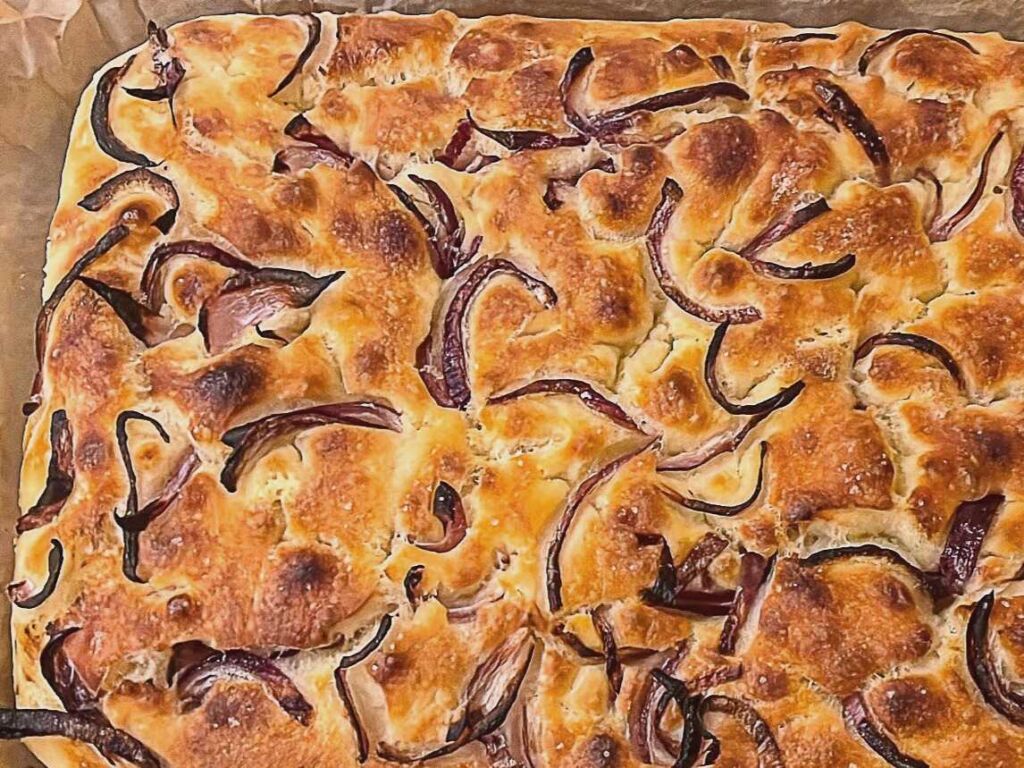
focaccia con cipolle rosse
Focaccia is one of the more popular Italian bread varieties. It’s a fun one to make because it doesn’t require a lot of effort or muscle like kneading, shaping, forming, or general tending to, which is great for beginners and also lazy bread makers.
This red onion focaccia recipe doesn’t need a rolling pin, pizza stone, food processor, or any fancy paddle attachment to make this homemade bread. This basic focaccia recipe comes out soft and airy – an ultimate comfort food!
This is a high-hydration dough, meaning it has a high proportion of water relative to flour. You will actually pour the dough into the pan rather than place it.
This can feel very disconcerting and lead to the question, “how can this possibly turn into bread?”. But alas, you put the pan into the oven, say a prayer (and in Italy, there are so many churches that I feel the odds of my prayers being answered has increased), and 30 minutes later, you have golden brown yeasty deliciousness.
I have come across many variations of focaccia recipes and watched a few Italian videos of women digging their fingertips into the beautifully oily, squishy, and bubbly dough. They rattled off what sounded like very important bread making tips, but my grasp of the Italian language is minimal, so I hope it wasn’t too important.
Ingredients
- Flour – type 0
- Dry brewer’s yeast
- Sugar
- Water
- Extra virgin olive oil
- Salt
- Red onion
The flour aisle in an Italian grocery store is quite different than in America. So, I learned quickly that it will be easier to follow an Italian recipe than try to convert one from Bon Appetit or Ina Garten.
This red onion focaccia recipe uses the Italian Type 0 flour, which has a high gluten content and is ideal for breadmaking.
It also has the inclusion of red onion to the topping – might as well gild the lily.
Step by Step
First, measure the flour into a clean bowl.

Water should be warm to the touch. You want the lukewarm water to melt the yeast but not so warm that it kills the yeast. Instant yeast doesn’t need to be proofed first but sometimes I do anyway. I like having the peace of mind of seeing the yeast wake up and get bubbly and frothy.
Stir in about a teaspoon of sugar into the warm water as well. Like all of us, yeast needs a little sugar to perk up! I don’t have a whisk so I’m using a fork, which is almost like a whisk that got flattened. *Imagination.* Let the yeasty water rest for about 5 minutes while you prepare the onion topping.
Slice one small red onion into half-moons. When you slice an onion in half lengthwise, you can then keep slicing in the same direction to get one type of curved shape or turn the onion 90 degrees and slice in the other direction and you achieve curves that are more of a rainbow shape.
I’m sure some professional chefs say there is a right and wrong way, but I am not a professional chef, so choose whichever way looks prettier to you. That’s my “professional” advice.
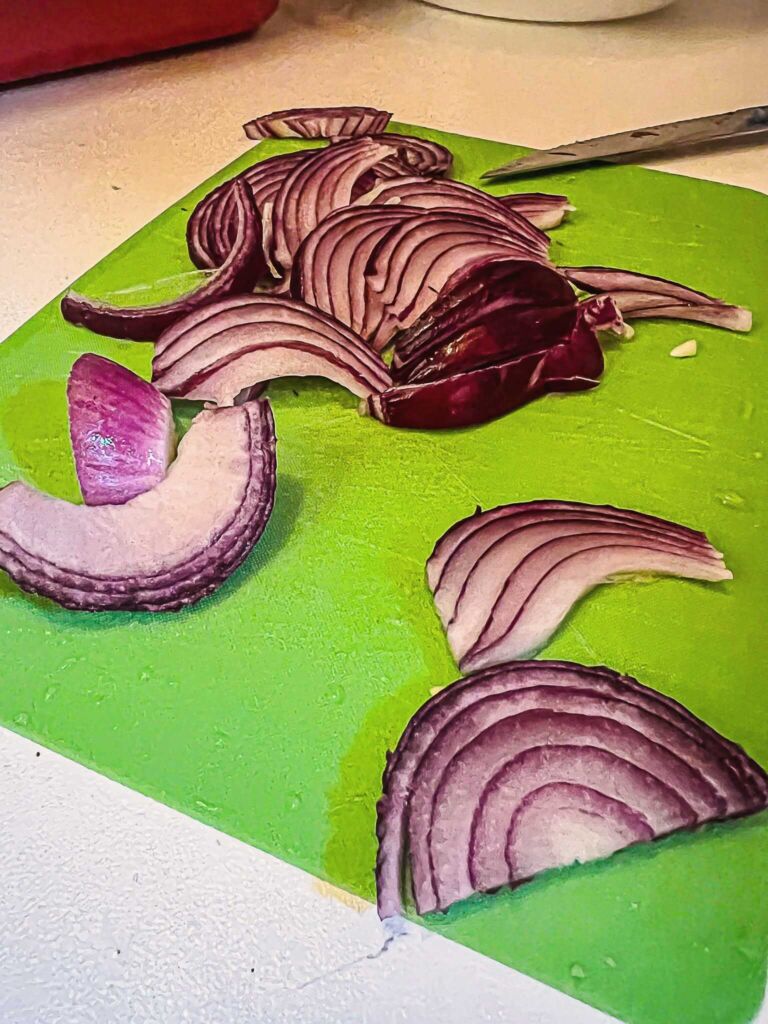
Separate the pieces and put them in a bowl, sprinkle with a teaspoon of salt to draw out moisture from the onions, and then cover them with another bowl. Put any jar or can on top as a weight and leave it on the counter or in the fridge while you continue to prepare the bread dough.
Pour the yeasty water mixture into the bowl with the flour and stir with a wooden spoon. I’m not sure why, but every bread recipe says to mix with a wooden spoon so that must be an ancient secret of flour, yeast, and water harmonizing mastery.
Then mix in the extra virgin olive oil, cover and let rest for 20 minutes. This will allow the flour to start absorbing some of the water and thicken slightly. You might even see little bubbles forming already on top; the yeast mixture acts fast!

After 20 minutes, uncover and add the salt and stir the dough in a folding motion with your trusty wooden spoon, taking from the outer edges of the mixing bowl and turning the dough up and inwards towards the middle. Do this once all the way around the bowl, just until the salt is incorporated.
Cover the bowl with plastic wrap or a tea towel, and let rise on the counter for 1½hr – 2hr. Because the dough is so hydrated, it is not going to rise really tall and puffy, like some other types of dough, but it should have grown slightly and be bubbly. It might have the look of a science experiment – in a good way!
Next, pour the dough into an oiled 35x25cm pan. drizzle oil over the top, and gently press with your fingertips to spread out the dough starting in the middle and working outwards. It doesn’t need to hit every corner, the dough will continue to relax and spread out. Cover with plastic wrap or a tea towel and let rest for 30-45 minutes.
Preheat the oven to 200 °C. Rinse out the salted onions in a colander and pat dry on a paper towel. Sprinkle them on top of the focaccia and drizzle with olive oil. Then press your fingers into the dough to create dimples, slightly pressing onions into the dough. Sprinkle with a pinch of salt and drizzle with more olive oil. I personally feel the secret to focaccia is excessive amounts of olive oil.
Bake in preheated oven for about 30 minutes or until golden brown.

Tips and FAQs
Variations
Toss cherry tomatoes in a bowl with olive oil, grated garlic, and coarse sea salt. Spoon on top of the dough at the final step when dimpling for an excellent focaccia topping.
Another of my favorite toppings is olives and fresh rosemary!
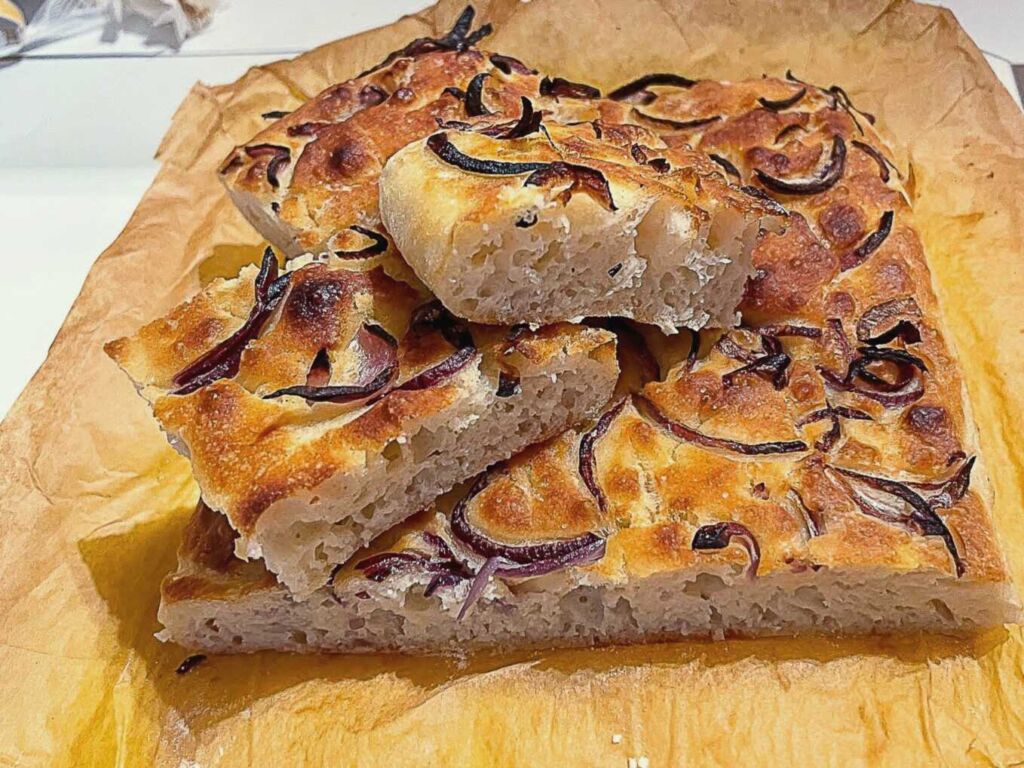
Red Onion Focaccia Recipe
Red Onion Focaccia
8
servings25
minutes35
minutes3
hoursIngredients
500g Type 0 flour – *see note
3g dry brewer’s yeast – *see note
1 tsp sugar
400g warm water
30g extra virgin olive oil
10g salt
- Topping:
1 small red onion
1 tsp salt
1 Tbsp extra virgin olive oil
Directions
- Add flour to a large bowl.
- In a measuring cup, dissolve yeast and sugar into warm water and let stand for 5 minutes.
- Cut the red onion in half lengthwise and thinly slice into half-moons. Separate slices into a bowl and sprinkle with salt. Place another bowl on top and weigh down with a jar or can. Set aside.
- Make a well in the middle of the flour and pour in the yeast and water mixture. Add olive oil. Stir with a wooden spoon until the mixture is smooth. Cover and let rest at room temperature for 20 minutes.
- Uncover and sprinkle with salt. Using a wooden spoon, stir dough by making a folding motion, scooping from the outer edge of the bowl, and turning the dough towards the middle. The dough will be very wet, almost like a cake batter consistency. Continue the folding motion once around in a circle, ensuring the salt is incorporated.
- Cover and let rise at room temperature for 1 ½ – 2 hours. The dough will not necessarily double in size but should have grown and look bubbly.
- Pour dough into an oiled 25x35cm pan, drizzle oil over the top, and gently press with your fingertips to spread out the dough starting in the middle and working outwards. It doesn’t need to hit every corner, the dough will continue to relax and spread out.
- Cover with plastic wrap and let rest for 30-45 minutes. Preheat oven to 200 °C.
- Rinse red onions in a colander and pat dry on a paper towel. Sprinkle them on top of the dough and drizzle with olive oil. Press fingers into the dough to create dimples, slightly pressing onions into the dough. Sprinkle with salt and drizzle with more olive oil.
- Bake for 25-35 minutes or until golden brown.
- Cool in pan for 10 minutes and then remove to wire rack. Can be served warm or cold.
Notes
- * Bread flour can be substituted in an equal amount for the Type 0 flour
- * In Italy, I use Paneangeli Mastro Fornaio Lievito di Birra. Feel free to use whatever brand of instant or rapid rise yeast you prefer.
More recipes
Sicilian Swordfish with Eggplant and Tomatoes
Borlotti Bean and Vegetable Soup
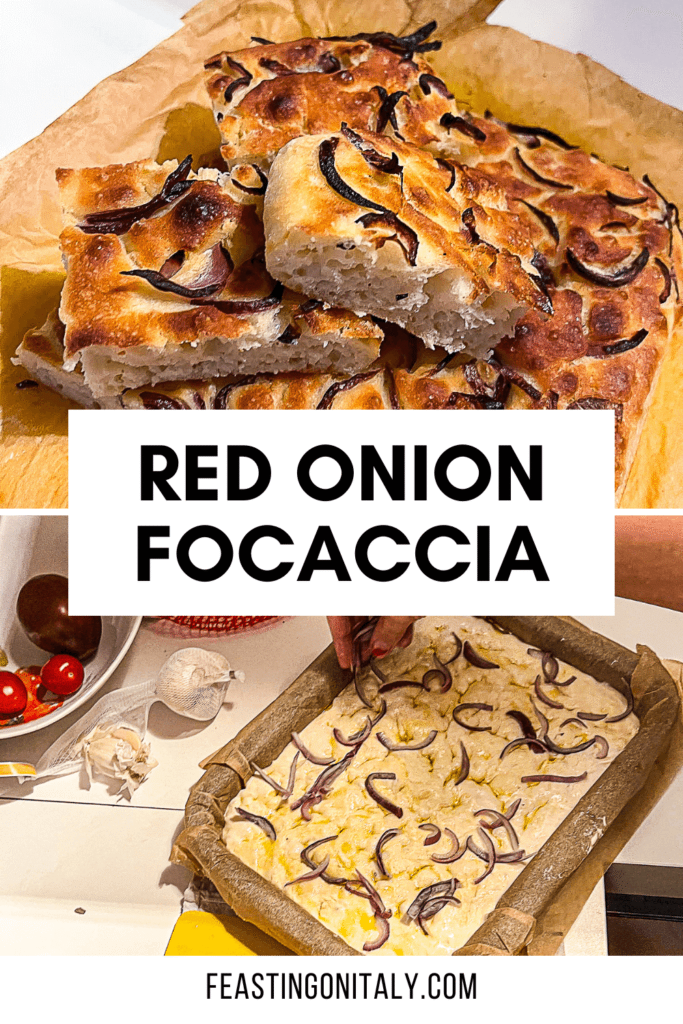
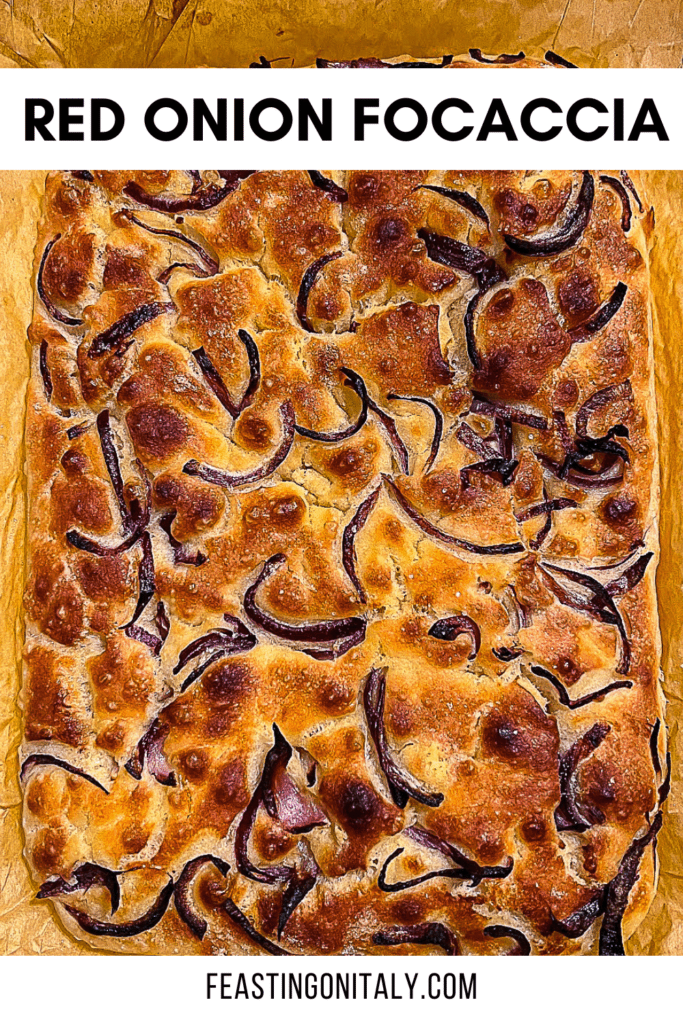

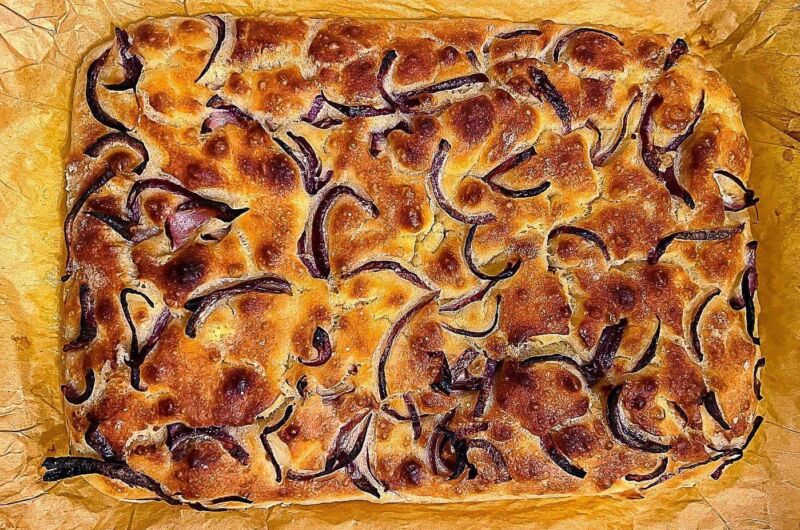



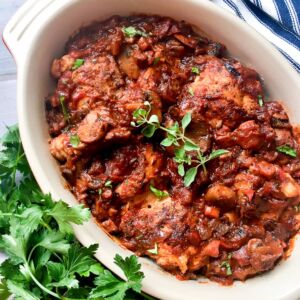

Leave a Reply
You must be logged in to post a comment.